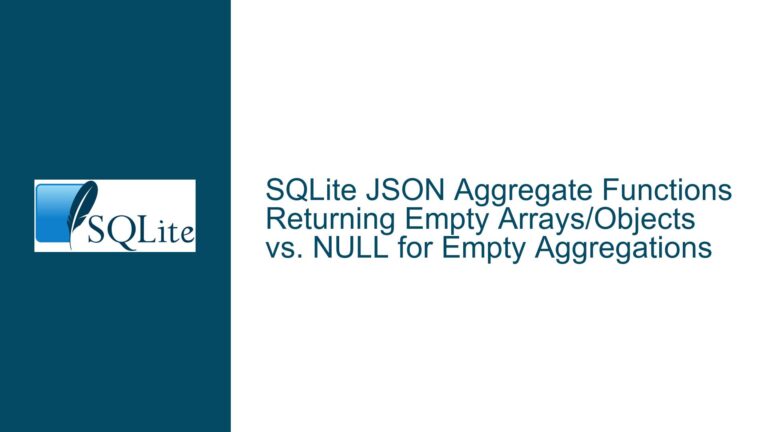Resolving Transaction Rollback and Commit Conflicts in SQLite Schema Constraints
Transaction Rollback Due to Constraint Violation Preventing Commit
Transaction Integrity Error When Handling Unique Constraints in Multi-Table Inserts
Issue Overview: Constraint-Driven Rollbacks Invalidating Subsequent Commit Attempts
The core problem arises when a SQLite transaction is automatically rolled back due to a constraint violation (e.g., UNIQUE or CHECK), leaving an explicit COMMIT or END TRANSACTION command invalid because no transaction is active. This occurs in scenarios where a script attempts to insert data into multiple tables with interlinked constraints.
In the provided schema, the food_item table generates a shared item_id for entries classified as "fruit" or "vegetable." The fruit table references food_item.item_id while enforcing a UNIQUE constraint on fruit_type. The transaction begins by inserting a food_item record, then attempts to insert a corresponding fruit record using the newly generated item_id. If the fruit insertion fails (e.g., due to a duplicate fruit_type), the INSERT OR ROLLBACK clause forces an immediate rollback of the entire transaction. Subsequent execution of END TRANSACTION (equivalent to COMMIT) then fails because the transaction was already terminated by the rollback.
This creates a paradox: the transaction is designed to atomically link the creation of food_item and fruit records, but the rollback triggered by the second insertion invalidates the final commit. Additionally, the use of MAX(item_id) to associate records introduces race conditions in multi-user environments, as it assumes no concurrent modifications to food_item during the transaction.
Possible Causes: Constraint Enforcement and Transaction Lifecycle Mismanagement
Implicit Rollback via
INSERT OR ROLLBACK:
TheOR ROLLBACKconflict resolution clause in thefruittable insertion forces an immediate rollback of the entire transaction upon constraint violation. This terminates the transaction before the script reachesEND TRANSACTION, rendering the commit invalid.Premature Transaction Termination:
Transaction control commands (BEGIN,COMMIT,ROLLBACK) are designed to be explicitly managed. When an intermediate operation likeINSERT OR ROLLBACKtriggers a rollback, subsequent transaction commands have no effect, leading to errors.Misuse of
MAX(item_id)for Referential Integrity:
Relying onMAX(item_id)assumes that no other transactions modifyfood_itembetween the insertion and theSELECT MAX(...)query. In reality, concurrent transactions could alter the maximumitem_id, causing incorrect associations betweenfood_itemandfruitrecords.Autoincrement Behavior Misunderstanding:
SQLite’sINTEGER PRIMARY KEYautoincrement mechanism does not reuse rolled-back IDs. Even if a transaction inserting intofood_itemis rolled back, the internal sequence counter is not reset, leading to gaps initem_idvalues. This contradicts the assumption that rolling back prevents "using up" anitem_id.
Troubleshooting Steps, Solutions & Fixes: Ensuring Atomicity Without Premature Rollbacks
1. Replace INSERT OR ROLLBACK with Explicit Error Handling
Remove the OR ROLLBACK clause from the fruit insertion to prevent automatic rollbacks. Instead, allow the transaction to remain active after an insertion failure, then conditionally roll back or commit based on the success of all operations.
Modified Script:
BEGIN TRANSACTION;
INSERT INTO food_item(item_type) VALUES('fruit');
INSERT INTO fruit(item_id, fruit_type)
SELECT item_id, 'apple'
FROM food_item
WHERE item_type = 'fruit'
ORDER BY item_id DESC
LIMIT 1;
-- Check if the last insertion succeeded
COMMIT;
Error Handling in CLI:
While SQLite’s command-line interface (CLI) lacks procedural logic (e.g., IF statements), you can use .bail on to halt execution on error, preventing an invalid commit:
.bail on
BEGIN TRANSACTION;
INSERT INTO food_item(item_type) VALUES('fruit');
INSERT INTO fruit(item_id, fruit_type)
SELECT item_id, 'apple'
FROM food_item
WHERE item_type = 'fruit'
ORDER BY item_id DESC
LIMIT 1;
COMMIT;
If the second INSERT fails, .bail on stops script execution, leaving the transaction open. Manually issue ROLLBACK to terminate it.
2. Use SAVEPOINT for Granular Transaction Control
SAVEPOINT creates nested transactions, allowing partial rollbacks without terminating the entire transaction. This isolates the fruit insertion’s failure while preserving the ability to commit other operations (though this is not desired here, as the goal is atomicity).
Example:
BEGIN TRANSACTION;
SAVEPOINT food_insert;
INSERT INTO food_item(item_type) VALUES('fruit');
SAVEPOINT fruit_insert;
INSERT INTO fruit(item_id, fruit_type)
SELECT item_id, 'apple'
FROM food_item
WHERE item_type = 'fruit'
ORDER BY item_id DESC
LIMIT 1;
-- If the insertion fails, roll back to fruit_insert:
ROLLBACK TO fruit_insert;
-- Optionally retry or abort
RELEASE food_insert;
COMMIT;
Limitations:
- The CLI cannot automatically handle
ROLLBACK TObased on errors. - Requires manual intervention or external scripting to execute
ROLLBACK TOafter detecting failures.
3. Eliminate MAX(item_id) Dependency with last_insert_rowid()
The last_insert_rowid() function returns the item_id of the most recently inserted row in the current session, avoiding race conditions caused by MAX(item_id).
Revised Script:
BEGIN TRANSACTION;
INSERT INTO food_item(item_type) VALUES('fruit');
INSERT INTO fruit(item_id, fruit_type)
VALUES (last_insert_rowid(), 'apple');
COMMIT;
Advantages:
- Directly references the
item_idgenerated forfood_item, ensuring correctness even with concurrent transactions. - Removes the need for
WITHclauses or subqueries, simplifying the logic.
4. Implement Application-Layer Transaction Management
For non-CLI environments (e.g., Python, Java), handle transactions programmatically:
Python Example:
import sqlite3
conn = sqlite3.connect('food.db')
cursor = conn.cursor()
try:
cursor.execute("BEGIN TRANSACTION;")
cursor.execute("INSERT INTO food_item(item_type) VALUES('fruit');")
item_id = cursor.lastrowid
cursor.execute(
"INSERT INTO fruit(item_id, fruit_type) VALUES (?, 'apple');",
(item_id,)
)
conn.commit()
except sqlite3.IntegrityError as e:
print("Fruit insertion failed:", e)
conn.rollback()
finally:
conn.close()
Benefits:
- Explicit commit/rollback logic based on operation success.
- Avoids CLI limitations by leveraging programming language features.
5. Restructure Schema to Enforce Business Logic via Triggers
Create a trigger on food_item to automatically insert into fruit or vegetable tables, centralizing constraint checks.
Trigger Example:
CREATE TRIGGER after_food_item_insert
AFTER INSERT ON food_item
FOR EACH ROW
WHEN NEW.item_type = 'fruit'
BEGIN
INSERT INTO fruit(item_id, fruit_type, item_type)
VALUES (NEW.item_id, 'apple', 'fruit');
END;
Usage:
INSERT INTO food_item(item_type) VALUES('fruit');
If the fruit insertion fails due to a duplicate fruit_type, the entire food_item insertion is rolled back.
Drawbacks:
- Triggers execute within the same transaction as the initiating
INSERT, ensuring atomicity. - Requires careful error handling to avoid unintended side effects.
6. Address Autoincrement Misconceptions and Key Gaps
Educate stakeholders that gaps in INTEGER PRIMARY KEY sequences are normal in SQLite and do not affect referential integrity. If gapless IDs are required, use a custom sequence table:
Sequence Table:
CREATE TABLE item_id_sequence (
current_id INTEGER NOT NULL DEFAULT 0
);
INSERT INTO item_id_sequence DEFAULT VALUES;
Manual ID Generation:
BEGIN TRANSACTION;
UPDATE item_id_sequence SET current_id = current_id + 1;
INSERT INTO food_item(item_id, item_type)
SELECT current_id, 'fruit'
FROM item_id_sequence;
INSERT INTO fruit(item_id, fruit_type)
SELECT current_id, 'apple'
FROM item_id_sequence;
COMMIT;
Considerations:
- Ensures gapless IDs but complicates schema design.
- Requires row-level locking to prevent concurrent updates in high-throughput environments.
By methodically addressing transaction lifecycle management, constraint enforcement, and SQLite’s autoincrement behavior, developers can resolve commit errors and ensure robust data integrity in multi-table insertion scenarios.






